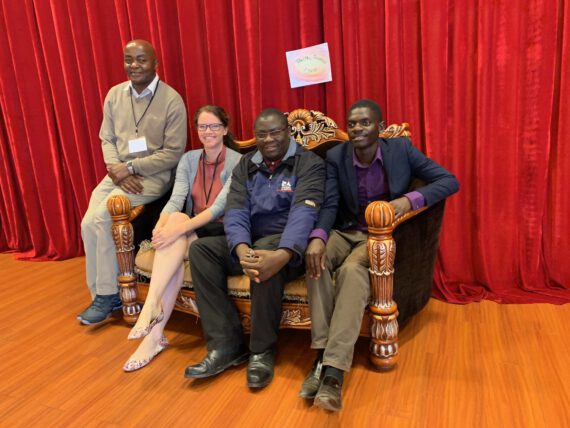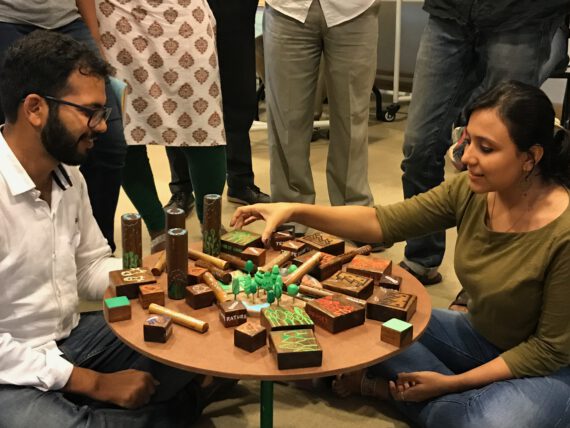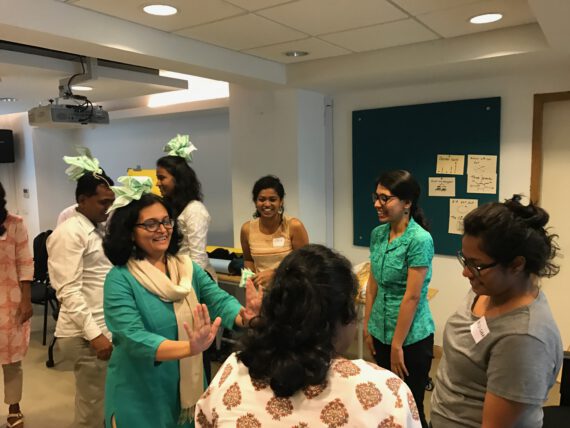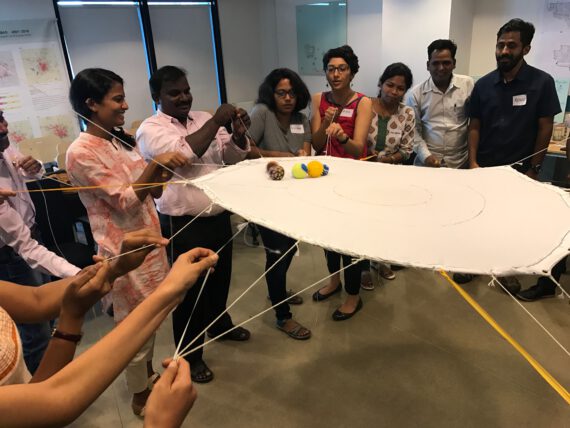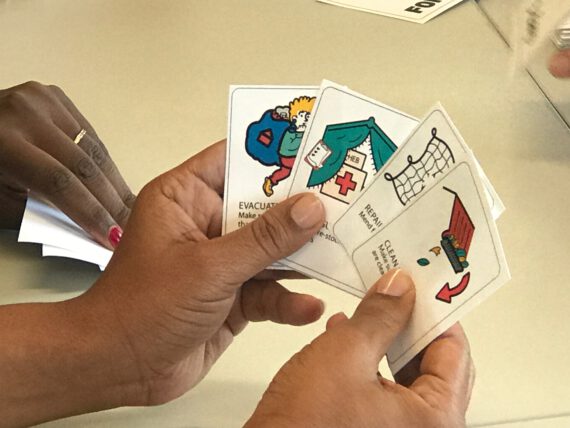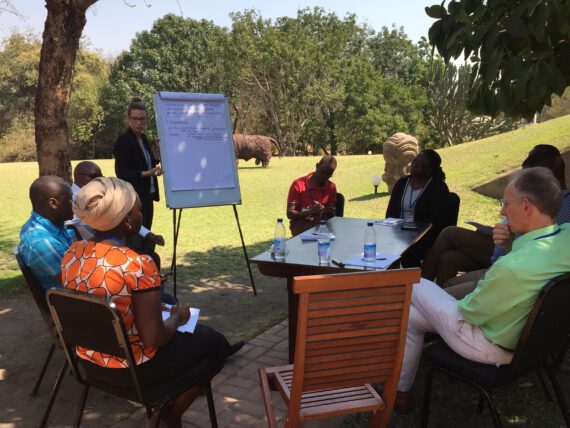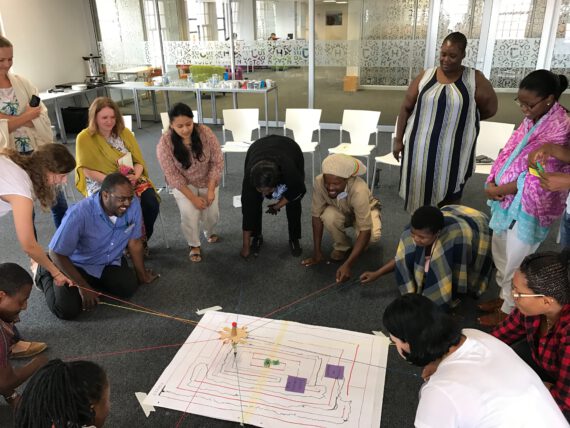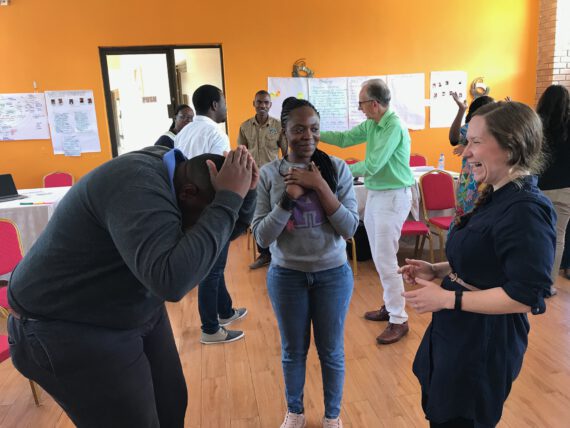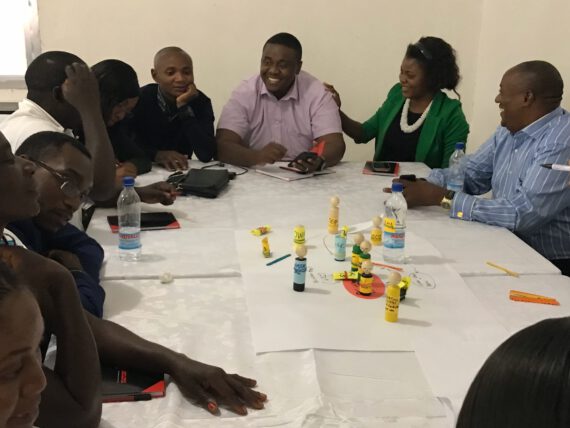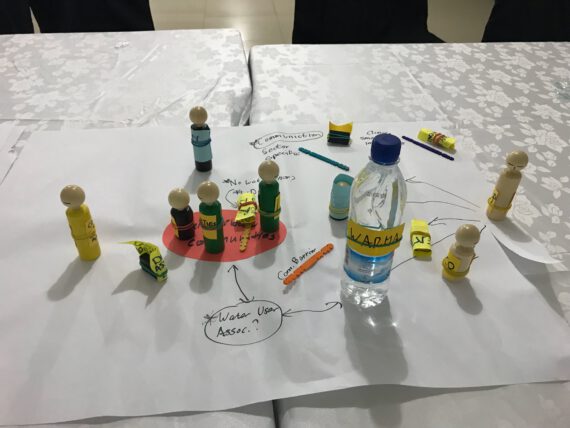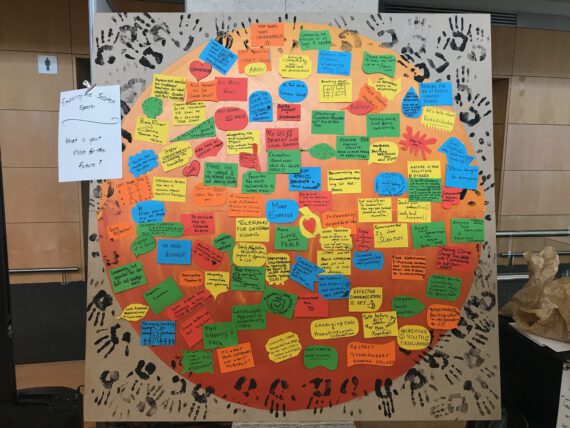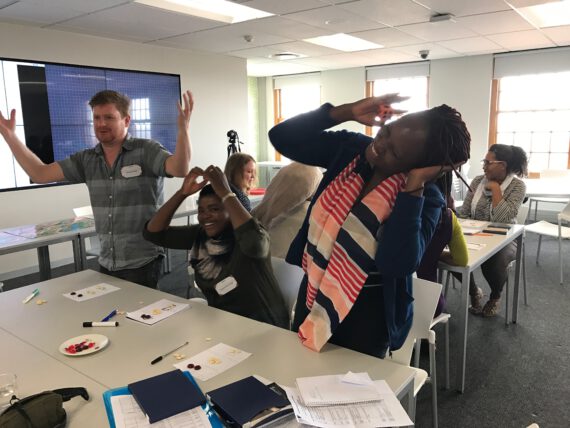Learn 18 innovative methods that spark participatory interaction between the event participants. The suggestions below are meant to inspire audience members to connect more deeply
with one another and with session content.
By Bettina Koelle, Paul Z Jackson, Carina Bachofen, Margot Curl
Processes before and during the conference
1. Crowd-sourced installations
Objective: Provide a quick overview of a range of topics, followed by more in-depth discussion.
Crowd-source ideas and thoughts in the lead-up to the conference through the use of a hashtag. Ideas can also be crowd sourced onto a Pinterest board and used as a real-world visual display at the event. Not only does this format offer an interesting visual component but also gives delegates a sense of ownership and interest when they look for their contribution on the wall. This can also be repurposed into a printed memento for attendees to take away with them after the event
2. Flash mob
Objective: Raise awareness or flag an important issue through an unusual and seemingly random performance that brings people together and causes bystanders to stop what they’re doing and pay attention.
Flash mobs are highly disruptive, energetic, and fun movement-based demonstrations that grab the attention of the public to highlight a certain theme or topic.
A flash mob needs careful preparation or a broader social medial campaign to ensure a crowd gathers at a certain time (and for a certain purpose).
3. Surprise session
Objective: Create a buzz around an event’s programme and use curiosity and anticipation as a means to attract people to an important session and generate interest in the programme.
Tweet teasers in the lead up to the event and secure an influential thought leader to deliver a surprise keynote in an interesting location. The surprise could be a speaker or indeed anything that’s not expected by the delegates, e.g. a visit to another venue for part of an event. Clues can be set up to lead delegates to the location (this can also be done in the evening during a cocktail reception).
Processes during the conference
4. Talk to me about ‘X’
Objective: Allow delegates in a conference to effectively network on a specific theme/topic.
Major themes are placed on a board by the registration desk or in the exhibition area along with associated colour coded stickers. Delegates can then put these stickers on their badges and identify and approach other delegates who wish to discuss the same issues during networking breaks.
5. Case-study snapshots
Objective: Provide a snapshot of case studies using short presentations with images.
To engage a variety of stakeholders in delivering insights and perspectives into critical issues, schedule a session of short case study snapshots where participants are allocated five to ten minutes and/or a restricted number of slides to provide a dynamic overview of their research/project. To keep this interesting, presenters could be advised to provide slides that only use images or only use text in interesting mood boards or mind maps. Alternatively, these presentations could be produced as multi-media platforms.
6. Serious games
Objective: Provide an experiential learning activity to introduce or interrogate a topic in an energizing and insightful way.
Serious games encourage active engagement and can provide an excellent introduction to a session theme. They stimulate reflections on the topic from unusual viewpoints, possibly allowing delegates to let go of their preconceived agenda. And finally, these games are fun and emotions can help us to learn more effectively about a serious topic. There are a range of game activities on the Climate Centre website. It is important that the serious game matches the level of risk the audience might be willing to take and the skills of the facilitator!
Session formats
7. Speed-geeking
Objective: Provide a dynamic and interactive beginning to a session on a certain topic.
Several presenters (or geeks) are spread around the room and are given five minutes to pitch their idea or theory to a small group of the audience. After five minutes a bell rings and participants move on. This can be wrapped up by a ten-minute discussion within each group of participants where they discuss and agree upon the most innovative or influential pitch and submit this to the chair. The chair can then review the choices and give the floor to the speaker who delivered the best pitch. A Q & A surrounding their idea or theory can then be conducted.
8. Ignite Talks
Objective: Provide a stimulating and possibly provocative start to a participatory session on a specific theme.
Speakers have five to ten minutes to tell strong and possibly provocative stories about big themes to generate awareness and stimulate thought (could also be a Ted-like talk). This session can include a series of controversial ignite talks in the beginning – then followed by a deep dive in the form of group work on some of the issues presented.
9. Lightning talks meets World Cafe
Objective: Provide a quick overview of a range of topics, followed by more in-depth discussion.
A few speakers give a three- to five-minute presentation of a topic that will then be followed up by table discussions. This gives participants the opportunity to engage in a series of small group discussions facilitated by different experts on a variety of topics relevant to the conference theme.
10. Learning clinic
Objective: bring out the collective wisdom of a group to address a specific challenge.
Learning clinics are a structured session that will allow some delegates to share their challenge/problem and can then draw on the collective insights of the group to discuss possible solutions or approaches to address the situation. It is useful to have a few persons share their challenge in parallel – and then to switch groups after a set time (e.g. 30 minutes), repeating the consultation. There are six phases in this approach:
1. Preparing: The person who wishes to receive help (the presenter) comes to the meeting with a specific request.
2. Presenting: The presenter outlines the situation to the team. The team listens attentively without interrupting and lets the presenter finish.
3. Clarifying: The team asks questions to understand the situation more clearly.
4. Affirming: Each team member tells the presenter what has impressed him or her most about how he or she is handling the situation.
5. Reflecting: The presenter retreats a little from the group and the team members take it in turn to go round the table and offer one item at a time of appropriate input.
6. Responding: After the reflections, the presenter responds briefly to what has been said.
11. Talk show
Objective: Provide a format that allows a complex issue to be unpacked in a light format.
The session will have one of several interview partners that are questioned by a journalist/TV host. This format could be considered for a keynote speaker/thought leader/influencer. The interviewer can ensure that jargon is explained, and key messages or challenges are clearly articulated. This session should be followed by a more interactive session, allowing for audience participation to deepen the statements made in the interview.
12. The book club
Objective: Share some material and discuss this more in depth in smaller groups
Materials are distributed and introduced to the group. This can be a shared text, testimonial, a story or a video. Ask the group to discuss in smaller groups, then provide turns to each group to give a short report back on the key points discussed.
13. À la carte session
Objective: Create an engaging session where the audience decides what is presented next.
The presenter starts by sharing his menu of topics with the audience. At regular intervals the audience can then vote what should be presented/ discussed next. This session works well with the topics being clearly shared on a large flip chart paper or on a power point slide.
14. Investigative reporter
Objective: Ensure that a complex presentation is broken up into smaller pieces without jargon and allowing the audience to follow more effectively.
In the course of a more standard session design, a critical reporter is placed in the session (and near the presenter). This reporter can hold up a small colourful card or sign to ask a question at any time in the presentation. This can be questions to explain jargon, explain complex contexts or technical aspects. The critical reporter can also ask questions of clarification, summary and possibly some “so what?” questions and check-in with the audience for further questions. Note that not all presenters would agree to such an intervention, and that the facilitator should ensure that the engagement is light and to the point, including a pinch of humour.
15. Poster chase
Objective: Provide the space for a quick, engaging and structured brainstorm on a couple of pre-defined themes.
The facilitator prepares a couple of posters around the rooms with topics or questions that should be discussed. Each poster can have a host remaining at the poster, documenting the discussion/brainstorm. Other delegates are invited to roam the room and contribute to the posters/topics that they are most interested in.
16. Scenario-based panel discussions
Objective: Explore complexity of a theme using several different scenarios, unpacking the likely impact.
Topical scenarios are shared with a panel in advance. During the session the panellists discuss these scenarios in a moderated conversation. Additional scenarios can be put to the panel by the audience during the session. This can work well if you have stakeholders from across the value chain to provide their perspective and discuss further with opposing stakeholders.
17. Poll your audience
Objective: Generate an active interest and quickly gather data from the audience.
During plenary sessions, an easy way to gather information is by polling your audience. These can be simple yes/no questions, multiple choice questions, or even open questions. Depending on the question type, you could work with a simple gesture such as raising hands, or opt for a more advanced digital capturing of the data through an online platform. The latter ones can sometimes generate visually appealing feedback through word clouds or simple charts.
18. Learning marketplace to share innovations
Objective: exchange knowledge and tools, with participants encouraged to discover and share interesting innovations, ideas and products.
You can use a marketplace when you want to create a platform for the exchange of knowledge and tools, for example during a project or towards the end. A learning marketplace is made up of stand-holders and visitors: The stand-holder will share their products, typically using a table to display their innovation, idea or product. Visitors will browse the various stands at the marketplace and explore the many different innovations, ideas and products. See also this fact sheet for more information.
Facilitating creative conferences
In this document we have shares a number of options to creatively engage delegates in meeting and conference settings. We hope that this initial list will inspire you to offer more interactive and engaging events in the future. In designing and preparing for the conference process, it is important to keep a few key questions in the back of your mind:
1. Are you offering a conference that allows delegates with different learning styles to be comfortable?
2. Is the event designed in a way that it offers a balanced mix of high-energy and reflective sessions?
3. Do you feel you have an adequate facilitation team to facilitate the event?
4. Are all speakers and session hosts well briefed and understand the process?
For more information on conference or session design, please reach out to us at virtually@climatecentre.org.


